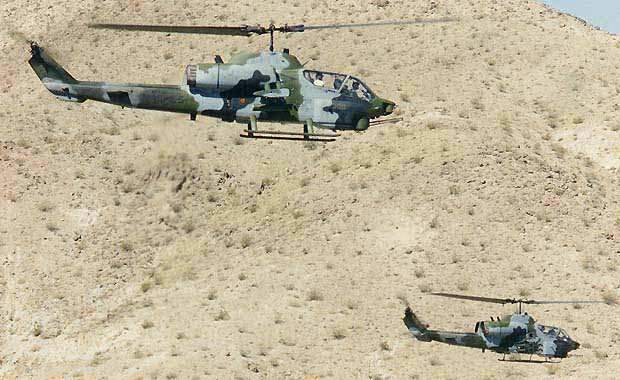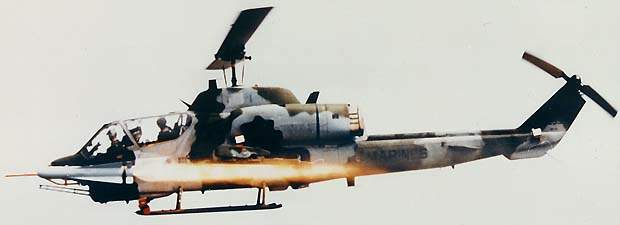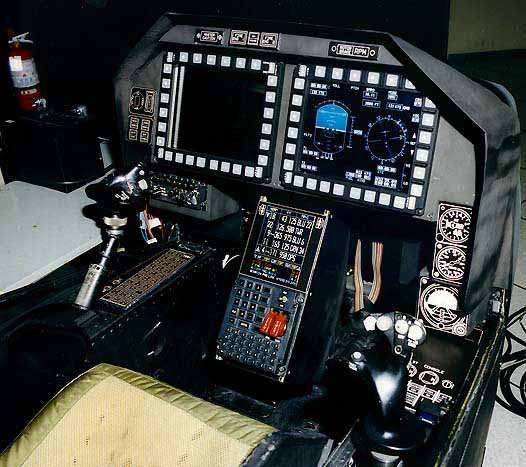When Did The Cobra Attack Chopper Enter Service
The AH-1W Super Cobra is the US Marines' assault helicopter. It is supplied past Bell Helicopter Textron, and entered service in 1985.
As well equally the US Marine Corps (USMC), the Super Cobra is operational with the Turkish Country Forces and the military of Taiwan.
AH-1Z Super Cobra upgrade programme
A major upgrade of the Bong Super Cobra known equally the H-ane plan was launched in 1996. The programme calls for the remanufacture of the U.s. Marine Corps fleet of 180 AH-1W Super Cobra into AH-1Zs and 100 UH-1N to UH-1Y utility helicopters to an advanced four-bladed configuration, which will operate to beyond 2020. An upgraded cockpit configuration allows easy co-pilot access to the night targeting organization (NTS). These are besides remanufactured with "zero-time" airframes comprising advanced engineering.
The original two-bladed semi-rigid, teetering rotor organisation is replaced with a iv-bladed, hingeless, bearingless rotor system. The improvement in flight characteristics provided past the four-bladed configuration led to an increase in flying envelope, maximum speed, vertical charge per unit-of-climb, payload and rotor vibration level.
The USMC subsequently decided on new-build rather than remanufactured UH-1Y helicopters and, in February 2008, awarded Bell a contract for the new build of 40 of the proposed 189 AH-1Z helicopters. Iv additional helicopters were ordered in September 2008.
AH-1Z Super Cobra beginning flying and development
First flight of the AH-1Z took place in December 2000. The AH-1W entered low-rate initial production (LRIP) in October 2003 with deliveries to be carried out until 2018. Five AH-1W helicopters were remanufactured to AH-1Z standard and took part in flight testing at NAS Patuxent River, Maryland. Sea trials in May 2005 included the first shipboard landing on USS Bataan, Wasp Course amphibious assault send.
Developmental testing was completed in Feb 2006 and two test shipping began operational evaluation (OPEVAL) with the USMC in May 2006. The showtime production AH-1Z helicopter was delivered to the USMC in Jan 2007. Phase II of OPEVAL began in February 2008, and the OPEVAL was completed in October 2010. In November 2010, the AH-1Z was approved for the full-rate production. Initial operating capability of the AH-1Z Cobra took place in Feb 2011.
The Turkish Army selected the AH-1Z Male monarch Cobra in July 2000 with a request for 50 out of a full requirement for 145 helicopters. In May 2004, information technology was appear that the acquisition was to be cancelled. The helicopters were to be congenital in Turkey by Tusas Aerospace Industries (TAI).
Cockpit
Northrop Grumman developed the integrated avionics systems for the AH-1Z. The systems include two mission computers and an automated flight control system with four-axis stability control augmentation system. Each crew station has two 8in×6in multifunction displays and one iv.2in×4.2in dual function brandish, based on agile matrix liquid crystal colour engineering.
The displays are supplied by L-iii Ruggedised Command and Control Solutions. Smiths Aerospace supplied the weapon stores control and data transfer system.
"The AH-1W Super Cobra helicopter was deployed in support of Performance Iraqi Freedom in March 2003."
The communications suite combines the new US Navy RT-1824 integrated radio, UHF/VHF, COMSEC and modem in a single unit. The navigation suite includes an embedded GPS inertial (EGI), a low-airspeed air information subsystem, which allows weapons delivery when hovering and a digital map.
In June 2002, Thales Avionics' TopOwl helmet-mounted display system was chosen for the USMC AH-1Z. The kickoff system was delivered in Jan 2003. TopOwl, also fitted on Tiger, NH90 and Rooivalk helicopters, has integrated Gen Iv image intensifier and FLIR capability and provides transition from solar day to night use at the push of a button.
Weapons and missiles
The Super Cobra tin carry both TOW and Hellfire anti-armour missiles and is qualified to comport the Maverick missile. The Raytheon BGM-71 TOW missile has a range of more than 3km and semi-automatic command-to-line-of-sight guidance. The AGM-114 Hellfire missile is manufactured by Lockheed Martin. It is equipped with a semi-active laser seeker and has a range of 7km. The Super Cobra has fire-and-forget capability when firing the Hellfire missile in branch style with laser target illumination.
The Super Cobra was the first attack helicopter to qualify both the Sidewinder air-to-air missile and the Sidearm anti-radiation missile. Both missiles tin can use the same LAU-7 rail launcher. Sidearm has a range of more than 15km. AIM-9L Sidewinder is an all-aspect, short-range, air-to-air missile produced by Lockheed Martin and Raytheon. The missile has a range of 15km.
The Super Cobra can fire the Hydra family of unguided 70mm rockets or the larger 127mm Zuni rocket bombs. Since 2008, all units are armed with the advanced precision impale weapon arrangement (APKWS), a guided version of the Hydra. The US Army reopened the contest for the APKWS in September 2005 and BAE Systems was selected as the prime number contractor on 27 April 2006. A $96.1m contract was awarded to BAE systems by the Us Army for design and development of APKWS II light amplification by stimulated emission of radiation guided rockets.
The Super Cobra carries a 3-butt, 20mm Gatling gun for close range (upwardly to 2km) engagement and 750 rounds of ammunition. With the gun in a stock-still forrard position, the pilot tin aim by manoeuvring the helicopter. Either crew member can slave the turret to the helmet-mounted sight and aim the gun by looking at the target.
"The Super Cobra carries a three-barrel, 20mm Gatling gun for close range appointment."
The AH-1Z for the USMC is being armed with: 16 Hellfire missiles, six AIM-9 Sidewinder air-to-air missiles, 70mm rocket pods (vii- and xix-shot), and a 20mm gun.
Sensors
Targeting for the AH-1W is provided past the night targeting organization (NTS), jointly produced by Tamam Sectionalisation of State of israel Aircraft Industries Ltd and Kollsman.
NTS integrates a frontward-looking infrared (FLIR) which provides automatic target tracking with a light amplification by stimulated emission of radiation designator / rangefinder and video recorder.
Lockheed Martin developed a longer range AN/AAQ-30 target sight system (TSS) for the AH-1Z to supplant the NTS. TSS includes a third-generation four field-of-view FLIR based on a 3-5-micron staring array, CCD color TV, Kollsman eyesafe light amplification by stimulated emission of radiation rangefinder / designator and multi-target autotracker. L-3 Communications Wescam supplies the turret assembly. Lockheed Martin was awarded a contract to supply the first 16 systems to the USMC in March 2008.
Longbow International (a joint venture of Lockheed Martin and Northrop Grumman) is developing the Cobra Radar System for the AH-1Z, based on the Longbow millimetre wave radar on the AH-64D Apache. Cobra is a pod-based radar that tin can exist mounted on a wingtip or in a stores position. Cobra can automatically search, detect, classify and prioritise multiple moving and stationary targets. It has a range of 8km confronting moving and 4km confronting stationary targets.
Countermeasures
The H1 Super Cobra upgrade includes the provision of a new electronic warfare suite. A new radar warner, the AN/APR-39(XE2) from Lockheed Martin, replaces the Lockheed Martin AN/April-39(V)ii pulse radar warner and the AEL Industries AN/APR-44 continuous-moving ridge radar warner.
The helicopters currently in service with the US Marines are equipped with the APR-39B(V)two digital radar alert receiver (RWR), provided by Northrop Grumman. The receiver volition exist replaced with Northrop Grumman's APR-39D(V)two RWR, which is designed to provide improved situational awareness through interactive management of the countermeasures and sensors onboard the helicopter.
The ATK AN/AAR-47 missile warning system was included in the upgrade suite. AN/AAR-47 uses infrared detectors to detect the missile plume. The Goodrich (formerly Raytheon) AN/AVR-2A laser warning receiver was besides added. The infrared countermeasures organisation is the AN/ALQ-144A developed by BAE Systems IEWS (formerly Sanders, a Lockheed Martin company).
"Super Cobra is armed with TOW missiles."
The helicopter is also equipped with the AN/ALE-39 chaff and infrared flare dispenser manufactured by BAE Systems Integrated Defense Solutions (formerly Tracor) and Lockheed Martin Tactical Defense Systems.
Engines
Twin General Electrical T700-GE-401 turboshaft engines provide a total of two,410kW or iii,380shp.
In standard atmospheric condition, with an air-to-air ordnance load, the Super Cobra can have off and climb out at more than iv.1m/s on only one engine. It can hover out of ground effect (OGE) at 914m, with a load of four TOW and four Hellfire missiles, full turret armament and rockets.
Performance
The helicopter can climb at the rate of 8.2m a second. The maximum and cruise speeds of the helicopter are 388km/h and 274km/h respectively. The range and service ceiling are 648km and 3,720m respectively. The maximum endurance of the helicopter is iii hours and xxx minutes. The helicopter weighs around 4,953kg and the maximum take-off weight is 6,690kg.
Orders and deliveries
Around 63 AH-1W helicopters were acquired by the Republic of China Army in 1990. As of January 2010, 59 helicopters were operational.
In 1990, the Turkish Ground forces procured ten AH-1W Super Cobras to supplement their AH-1F Cobras. Six helicopters were operational every bit of July 2010. Two more AH-1W helicopters were acquired in early 2011. Almost 167 AH-1W Super Cobra helicopters are being operated by the USMC.
"The AH-1W Super Cobra is the US Marines' attack helicopter."
The Republic of Korea Regular army obtained eight AH-1J Cobras in 1978 and three were in service as of January 2010.
The US Navy uses 7 AH-1Ws for test and rating purposes on behalf of the USMC. The marine corps took commitment of three upgraded AH-1s from Bell in Feb 2008. Bong received a contract for 15 upgraded aircraft (11 UH-1Ys and four AH-1Zs) in September 2008 and delivered 20 upgraded H-1 helicopters (fourteen UH-1Ys and half dozen AH-1Zs) in 2008.
The US Navy ordered sixteen Lot 6 H-1 helicopters (5 AH-1Zs and 11 UH-1Ys) in March 2009 totalling the entire contract to produce 65 upgraded H-1 aircraft (17 AH-1Zs and 48 UH-1Ys). Bell delivered six AH-1Zs and 17 UH-1Ys in March 2009.
In September 2008, NAVAIR (Naval Air Systems Control) ordered 46 AH-1Zs bringing its total orders to 226.
An AH-1W crashed at Camp Pendleton, California in September 2011 while conducting training exercises.
The Global Military Rotorcraft Market 2011-2021
This project forms office of our recent analysis and forecasts of the global war machine rotorcraft market place available from our business information platform Strategic Defence Intelligence. For more information click here or contact us: EMEA: +44 20 7936 6783; Americas: +1 415 439 4914; Asia Pacific: +61 2 9947 9709 or via email.
Topics in this article:
When Did The Cobra Attack Chopper Enter Service,
Source: https://www.airforce-technology.com/projects/ah1w-supercobra/
Posted by: suttonyoule1997.blogspot.com









0 Response to "When Did The Cobra Attack Chopper Enter Service"
Post a Comment